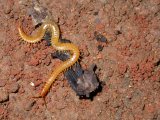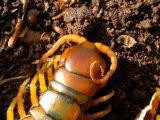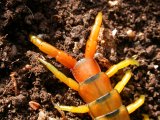About Chilopoda
CHILOPODA, or centipedes, are a class of terrestrial predators belonging to the phylum Arthropoda.



Morphology
The body of
centipedes is elongated to worm-like and
frequently flattened. A distinct head, covered by a flat head shield, is
followed by a multi-articulated trunk with one pair of legs on each
segment.
The head bears a
pair of frontal sensory appendages
(antennae) and three pairs of ventral mouth parts (mandibles, first
maxillae, and second maxillae). A pair of simple or (scutigeromorphs
only) multifaceted eyes are commonly present, but these sensory
structures are completely lacking in the geophilomorphs, in the
cryptopid scolopendromorphs and in many subterranean lithobiomorphs.
The trunk
appendages of the first pair are developed as
strong, conspicuous, stinging fangs, used to poison the prey and for
defence. Most of the other segments and their appendages are quite
uniform, but for the last pair of legs, which are often specialised in
shape and function, as either handling or sensory appendages. The
terminal part of the trunk bears a pair of small appendages (gonopods),
which are close to the genital opening and are often involved in
handling spermatophores.
Life cycle
Centipedes are oviparous. The female lays a small number of fairly
large eggs. In scolopendromorph and geophilomorph centipedes the eggs
are guarded continuously by the mother, which remains coiled around them
even after eclosion. Newly hatched individuals are poorly active and
abandon the brood only after moulting to a more mobile instar.
In some centipedes (Epimorpha, i.e. scolopendromorphs and
geophilomorphs) all body segments are formed at the end of the embryonic
phase, in the others (scutigeromorphs, lithobiomorphs
and craterostigmomorphs) the final segment number is achieved after a
series of moults. Maturity is generally reached after one year or more.
Egg fertilization relies on the indirect transfer of sperm by
spermatophores.
Ecology
Centipedes are a major component of terrestrial ecosystems throughout the temperate and tropical regions. Most of them move in the upper soil levels, among leaf litter and rock debris, others live deeper in the soil; the scutigeromorphs are surface-runner or cave-dwellers. Centipede diversity is highest in forest soils, but representatives of this arthropod group can be found from littoral shingle to cold montane prairies, from dump soil to arid ground. All centipedes are active predators, feeding on small invertebrates, sometimes even larger than them. The largest invertebrate carnivores in many terrestrial ecosystems are indeed centipedes.
Diversity
More than three thousand species have been described to date, but many other are waiting description. Five main lineages are recognisable among extant centipedes. The geophilomorphs are the most diverse and widespread. Of the other larger groups, the scolopendromorphs are well represented and diverse in the tropical regions, whereas the lithobiomorphs dominate in temperate areas. The very distinctive scutigeromorphs (‘house centipedes’) are much less diverse, and mainly tropical, while the craterostigmomorphs are represented by two species only.
General References
- Rosenberg J., 2009. Die Hundertfüßer. Chilopoda. Die Neue Brehm-Bücherei, 285. Westarp Wissenschaften, Hohenwarsleben, 524 pp.
- Minelli A. (ed.), 2011. Treatise on Zoology – The Myriapoda. Volume 1. Brill, Leiden, 530 pp.
